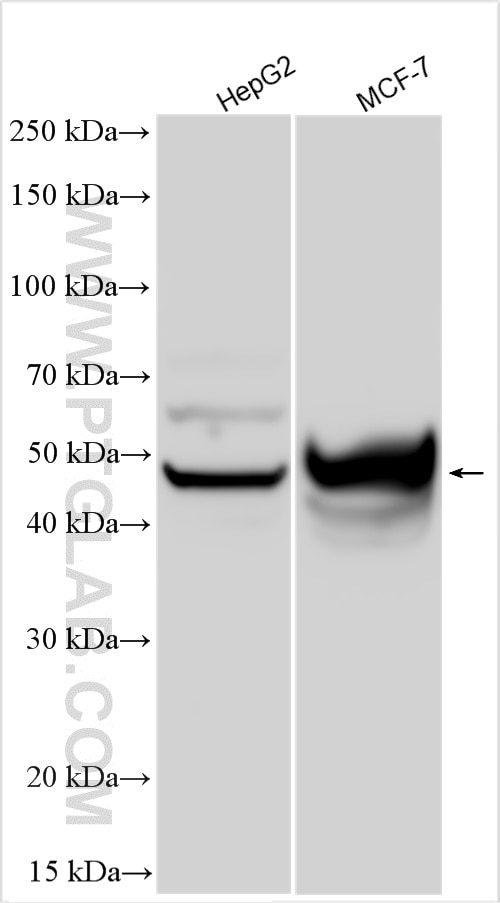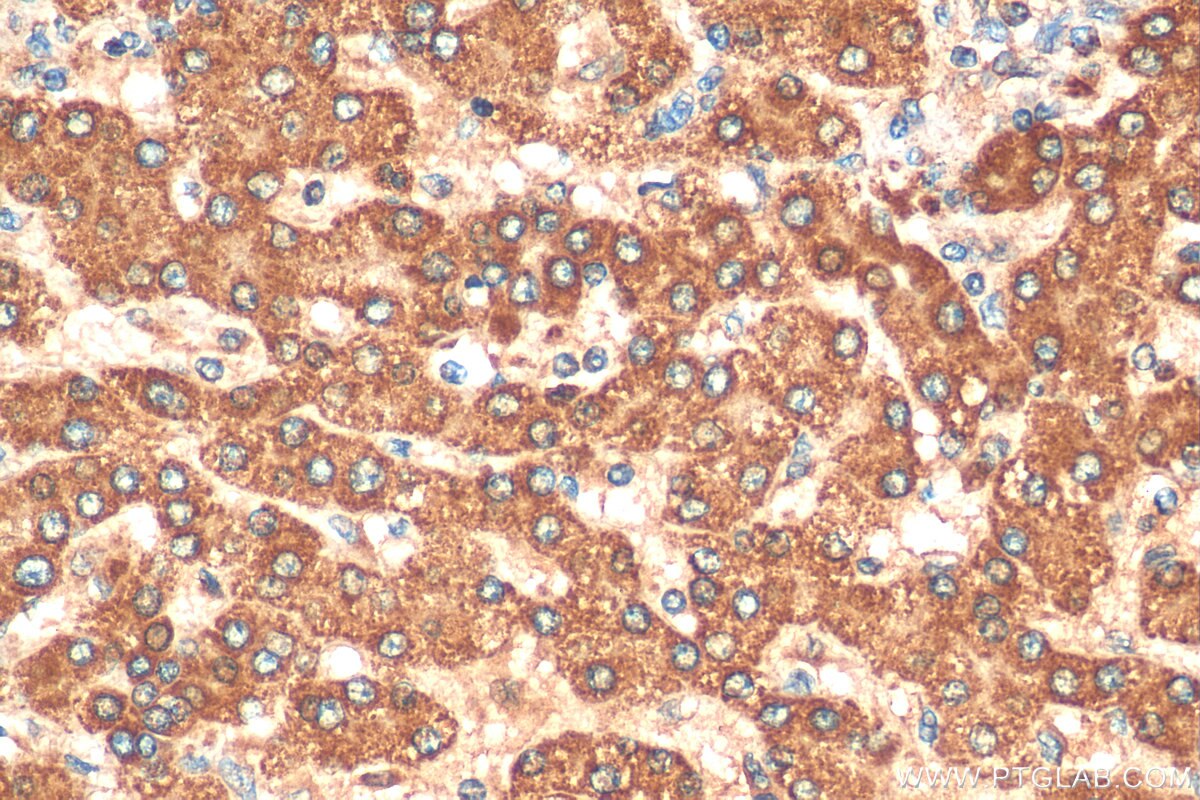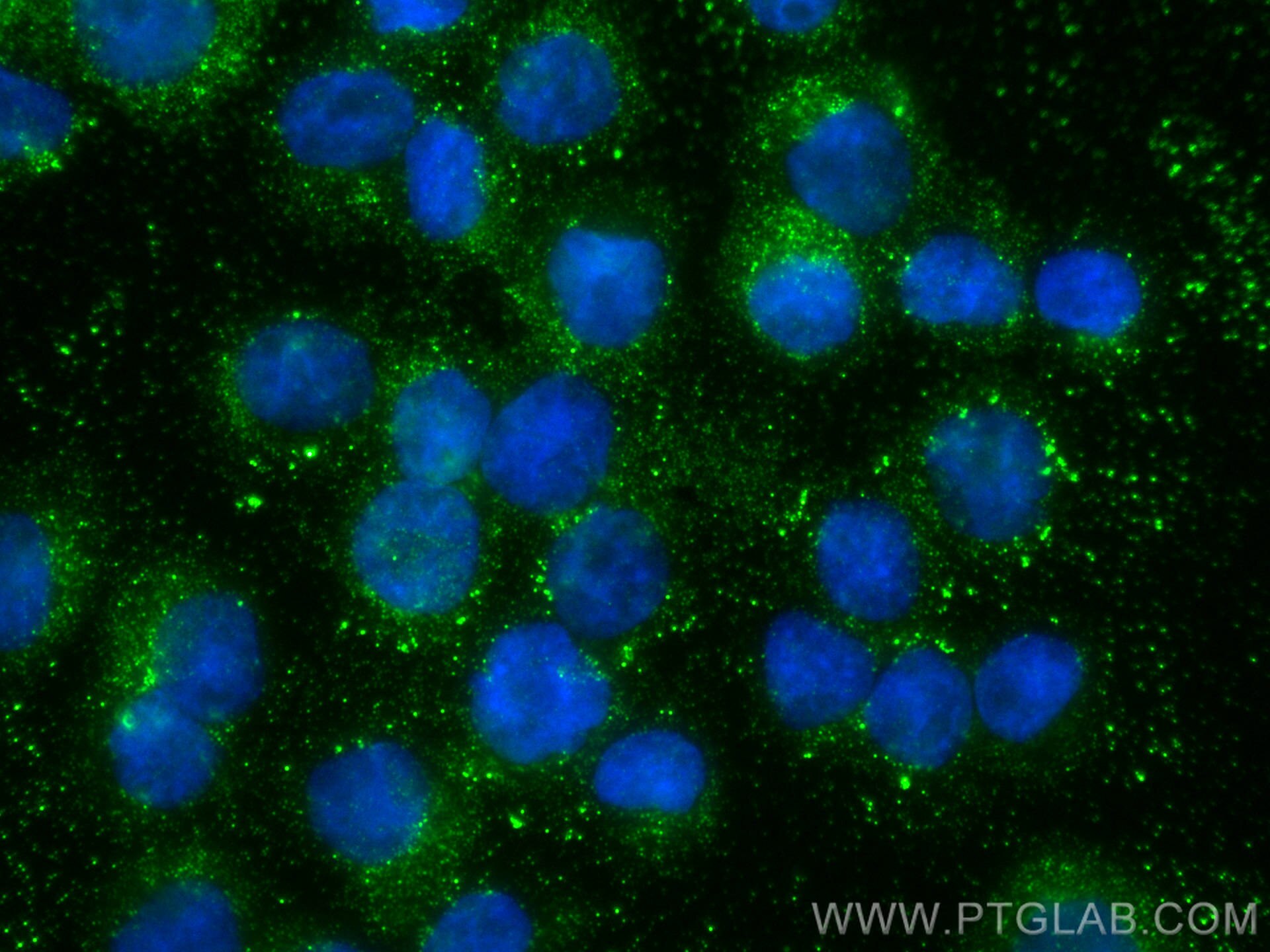Tested Applications
| Positive WB detected in | HepG2 cells, MCF-7 cells |
| Positive IHC detected in | human liver cancer tissue Note: suggested antigen retrieval with TE buffer pH 9.0; (*) Alternatively, antigen retrieval may be performed with citrate buffer pH 6.0 |
| Positive IF/ICC detected in | THP-1 cells |
Recommended dilution
| Application | Dilution |
|---|---|
| Western Blot (WB) | WB : 1:1000-1:6000 |
| Immunohistochemistry (IHC) | IHC : 1:50-1:500 |
| Immunofluorescence (IF)/ICC | IF/ICC : 1:50-1:500 |
| It is recommended that this reagent should be titrated in each testing system to obtain optimal results. | |
| Sample-dependent, Check data in validation data gallery. | |
Published Applications
| KD/KO | See 1 publications below |
| WB | See 6 publications below |
| IHC | See 1 publications below |
| IF | See 2 publications below |
Product Information
10396-1-AP targets ANGPTL7 in WB, IHC, IF/ICC, ELISA applications and shows reactivity with human samples.
| Tested Reactivity | human |
| Cited Reactivity | human, mouse |
| Host / Isotype | Rabbit / IgG |
| Class | Polyclonal |
| Type | Antibody |
| Immunogen |
CatNo: Ag0596 Product name: Recombinant human ANGPTL7 protein Source: e coli.-derived, PGEX-4T Tag: GST Domain: 44-334 aa of BC001881 Sequence: NCCEEVKELKAQVANLSSLLSELNKKQERDWVSVVMQVMELESNSKRMESRLTDAESKYSEMNNQIDIMQLQAAQTVTQTSADAIYDCSSLYQKNYRISGVYKLPPDDFLGSPELEVFCDMETSGGGWTIIQRRKSGLVSFYRDWKQYKQGFGSIRGDFWLGNEHIHRLSRQPTRLRVEMEDWEGNLRYAEYSHFVLGNELNSYRLFLGNYTGNVGNDALQYHNNTAFSTKDKDNDNCLDKCAQLRKGGYWYNCCTDSNLNGVYYRLGEHNKHLDGITWYGWHGSTYSLKR Predict reactive species |
| Full Name | angiopoietin-like 7 |
| Calculated Molecular Weight | 40 kDa |
| Observed Molecular Weight | 45 kDa |
| GenBank Accession Number | BC001881 |
| Gene Symbol | ANGPTL7 |
| Gene ID (NCBI) | 10218 |
| RRID | AB_2057556 |
| Conjugate | Unconjugated |
| Form | Liquid |
| Purification Method | Antigen affinity purification |
| UNIPROT ID | O43827 |
| Storage Buffer | PBS with 0.02% sodium azide and 50% glycerol, pH 7.3. |
| Storage Conditions | Store at -20°C. Stable for one year after shipment. Aliquoting is unnecessary for -20oC storage. 20ul sizes contain 0.1% BSA. |
Background Information
ANGPTL7, also named as CDT6, is a member of the angiopoietin-like (ANGPTL) family of proteins, which are important regulators of Angiogenesis. It is a secreted 45-kDa glycoprotein that folds into a homotetramer structure linked by disulfide bonds. ANGPTL7 was originally discovered in the stromal layer of the corne, and moderately expressed in the human trabecular meshwork. The chromosomal location of the ANGPTL7 gene (1p36.22) is within the GLC3B locus (1p36.2-1p36.1) of primary congenital glaucoma, supporting ANGPTL7 as a candidate glaucoma gene. ANGPTL7 could have a pathogenic role in glaucoma, and may serve as a potential therapeutic target.
Protocols
| Product Specific Protocols | |
|---|---|
| IF protocol for ANGPTL7 antibody 10396-1-AP | Download protocol |
| IHC protocol for ANGPTL7 antibody 10396-1-AP | Download protocol |
| WB protocol for ANGPTL7 antibody 10396-1-AP | Download protocol |
| Standard Protocols | |
|---|---|
| Click here to view our Standard Protocols |
Publications
| Species | Application | Title |
|---|---|---|
FASEB J Angptl7 promotes insulin resistance and type 2 diabetes mellitus by multiple mechanisms including SOCS3-mediated IRS1 degradation.
| ||
Osteoarthritis Cartilage Effects of mechanical stress and deficiency of dihydrotestosterone or 17β-estradiol on Temporomandibular Joint Osteoarthritis in mice. | ||
Front Mol Biosci An Extracellular Matrix-Based Signature Associated With Immune Microenvironment Predicts the Prognosis and Therapeutic Responses of Patients With Oesophageal Squamous Cell Carcinoma. | ||
Genes Cells Evidence for a role of angiopoietin-like 7 (ANGPTL7) in extracellular matrix formation of the human trabecular meshwork: implications for glaucoma. | ||
Commun Biol ANGPTL7, a therapeutic target for increased intraocular pressure and glaucoma | ||
Hum Mol Genet Rare protective variants and glaucoma-relevant cell stressors modulate angiopoietin-like 7 expression |
Reviews
The reviews below have been submitted by verified Proteintech customers who received an incentive for providing their feedback.
FH Kenzo (Verified Customer) (01-05-2024) | The antibody worked well for immunofluorescence on frozen mouse eye sections.
|








